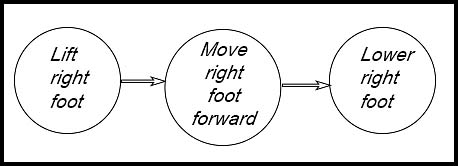Where the techniques of Maths
are explained in simple terms.
Networks - Basic terms.
Summary and concepts.
- Algebra & Number
- Calculus
- Financial Maths
- Functions & Quadratics
- Geometry
- Measurement
- Networks & Graphs
- Probability & Statistics
- Trigonometry
- Maths & beyond
- Index
| Network |
|
| Vertex or node | An activity or a stage in a network diagram. A vertex in a network diagram is a point representing:
In the above diagram, the vertices describe the action taking place. The arrows show what the next action will be.
In the second diagram above, the action is written along the arrow (called an edge) and the action is regarded as taking place between the vertices (shown as black dots). Both diagrams can be used:
You can use either - and you must be able to interpret both representations. Lines or pathways (i.e. edges) of the network intersect or branch out from a vertex. A vertex is also frequently referred to as a node. |
| Degree of a vertex | The number of edges coming into the vertex. |
| Edge | The line joining two vertices to each other. An edge could be curved and it is then described as an arc rather than a line. |
| Directed edges | Edges with an arrow to show the direction of the activity. |
| Weighted edges | Edges with a number indicating time, cost, distance, etc. |
| Path. | A path in a network diagram is a trail in which there are no repeated vertices (and of course where all of the edges are distinct).
An open path starts and finishes at different vertices. A closed path - called a cycle - starts and finishes at the same vertex. There may be multiple paths between the same two vertices. |
| Trail | A walk with no repeated edges. A circuit is a closed trail. |
| Walk. | Any route along the edges of a network. Edges and vertices can be repeated. |
| Flow. | The number or amount of a quantity flowing through a system or network - either through a part of the network or through the entire network. |
| Connected network | A connected network has a path between any two vertices. Often this path will span a number of vertices. |
| Degree of a vertex. | The number of edges connected to a given vertex.
An even vertex has an even number of edges connected to it. An odd vertex has an odd number of edges connected to it. |
| (Total) degrees in a network. | The sum of the degrees of all vertices in a network equals twice the number of edges - each edge has two vertices.
Hence the sum of the degrees in a network is always even. |
| Directed network | A network in which the edges between vertices only flow in the direction indicated. We read these as FROM ... TO .... |
| Weighted network. | A network in which the edges between vertices also have a value to indicate the amount of the characteristic required or involved. A weight could be:
The weight of a network is the sum of the weights along all edges. |

